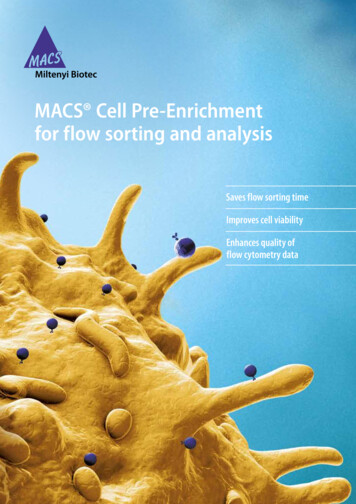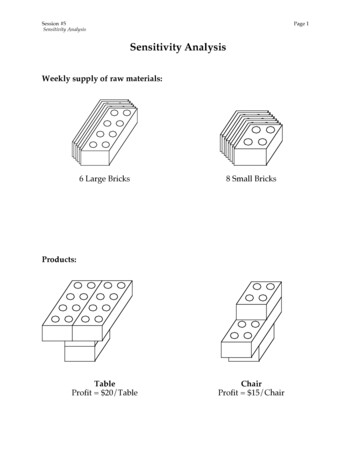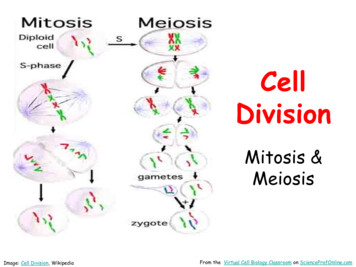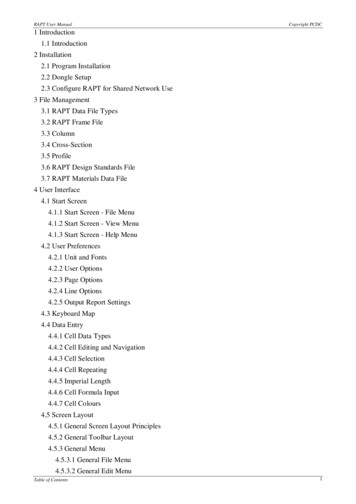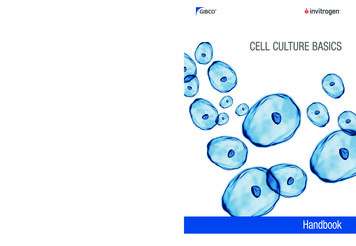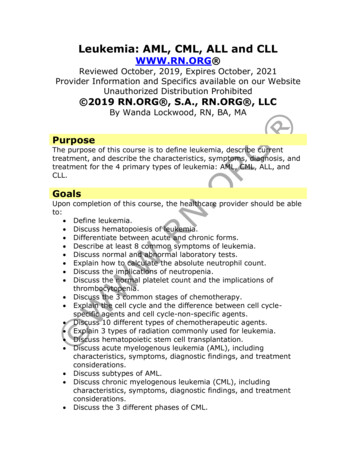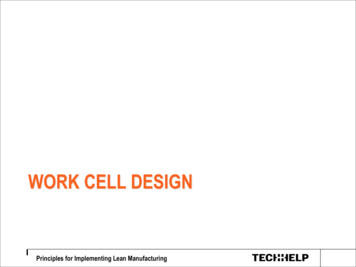
Transcription
WORK CELL DESIGNPrinciples for Implementing Lean Manufacturing
DefinitionCellular Flow Manufacturing is a method oforganizing manual and machine operations in themost efficient combination to maximize value-addedcontent and minimize waste.Cellular Flow
Lean Building BlocksContinuous ImprovementPull/KanbanQuality at SourceStandardized Work5S SystemCellular FlowCellular/FlowPOUSQuick ChangeoverBatch ReductionVisualTPMTeamsPlant LayoutValueStreamMapping
Cellular Manufacturing Benefits Simplified scheduling and communication Minimal inventory needed between processes Increased visibility provide quick feedback and problem resolution Development of increased product knowledge workers are trained to understand the total process Shorter lead times Small lots and one piece flow to match customer demandCellular Flow
Work Cell – Realization of a Lean Process A work cell’s effectiveness is not separable from relatedelements:- The product(s)- Workers must be able to manufacture and assemble the productto meet customer demand [DFA, DFM]- A breadth of products often must be accommodated by a singlemanufacturer [Product families]- The people(s)- Work cells must produce varying products and varying rates tomeet customer demand [Product families, Takt time]- Work cells must be designed such that workers can safely andrepeatedly perform necessary steps to meet customer demand.[Human factors]Principles for Implementing Lean Manufacturing
The Five Step Cell Design Process Group Products Establish Takt Time Review the Work Sequence Balance the Process Design the Cell LayoutCellular Flow
Product Grouping Considerations Similar Process/Resource Requirements Changeover/Set-up Times Process Time Variation Demand vs. CapacityCellular Flow
Product Grouping Tool:The Product/Process MatrixCellular Flow
Product Portfolio “The set of different product offerings that a companyprovides. Products can be unique, share commonsystems, and/or production methods.” Product portfolio architecture – “system strategy forlayout out components and systems on multipleproducts”- Otto and Wood, 2000 3 Portfolio Architectures1.Fixed unsharing – each product is unique, no sharing ofcomponents, typically very high volume2.Modular platform - share modules, components, orsystems to meet the needed variety - common elementsare called the platform and each supported product iscalled a variant3.Massively customizable – varies to meet customer need– either by customer (e.g. car seat) or manufacturer
The Five Step Cell Design Process Group Products Establish Takt Time Review the Work Sequence Balance the Process Design the Cell LayoutCellular Flow
More on Takt Time Takt time can change!! What can you change to match takt time?- Number of people- Number of cells (requires investment in machinery) Takt Time Rounding Rules: Crew size calculation for an assembly line doing one piece flowpaced to Takt Time is:- Crew size Sum of Manual Cycle Time / Takt Time If Manual Cycle Time 1,293 seconds and a Takt time 345 sec Crew size 1,293 person-seconds / 345 seconds Crew size 3.74 people In this case the crew size will be 4 people since 3 people would notbe able to meet customer demand.Example %20Takt%20Time.pdfCellular Flow
The Five Step Cell Design Process Group Products Establish Takt Time Review the Work Sequence Balance the Process Design the Cell LayoutCellular Flow
Steps in the Process① Observe and document the tasks each worker performs-Observe, don’t just ask-The steps are defined (explicitly or implicitly) by thedesigner② Break operations into observable segments③ Study machine capacity, cycle times, and changeovertimes④ Look for value-added and non-value-added elementsCellular Flow
The Five Step Cell Design Process Group Products Establish Takt Time Review the Work Sequence Balance the Process Design the Cell LayoutCellular Flow
Combine Work to Balance the ProcessCellular Flow
Standard Work Combination Sheet – ExampleCellular Flow
Alternative Work Market demand 220,000 units per yearTakt time 27 secondsCellular Flow
Staffing For Increased Demand1Lathe2Drill3Mill4Mill5Inspect19seconds19 seconds10Pack19seconds9Inspect6Drill19 seconds8Drill7TestMarket demand 312,000 units per yearTakt time 19 secondsCellular Flow
The Five Step Cell Design Process Group Products Establish Takt Time Review the Work Sequence Balance the Process Design the Cell LayoutCellular Flow
Design Goals for All Work Areas Flexible output Lot size of 1 Point of Use Storage (POUS) Mixed models Visual management Source inspection Zero NVA activitiesCellular Flow
)Water Pump Case StudyCirculation Pump Assembly �yRotorAss’yWeldContactAss’yRivetCellular lAss’y SolderWindBobbinMakeBoxPack
Water Pump Case StudyNew U-Shaped CellBobbinWindingTestingPackagingCellular Flow
Water Pump Case StudyWorkplace OrganizationMaterial flow chutesTools within reachCellular Flow
Water Pump Case StudyMachining and AssemblyMaterial Flow ChuteCellular Flow
Ergonomic Factors in Work Station (and Product)DesignDesign the work to: Minimize motion Avoid unnatural posturesand movements Avoid sharp turns in motion Make moves easy to performwithout much concentration Use hands and forearms insteadof upper arms and shouldersfor light work Minimize lifting Follow a rhythmCellular Flow
Tool and Material Design and LayoutGuidelines Place tools and materials close to and in front of theoperator Keep tools and materials in a designated place Design fixtures for specific purposes, not general purposes Combined usage tools are recommended when more thanone tool is requiredCellular Flow
Ergonomic ResourcesErgonomic resources areunderstandable, practical,and affordable.Fitting the Task to the Man: An ErgonomicApproach - GrandjeanThe Measure of Man and Woman: HumanFactors in Design – Tilley and DreyfussYour FE Resource GuideCellular Flow
Cellular Flow
Cellular Flow
Product portfolio architecture – “system strategy for layout out components and systems on multiple products” 3 Portfolio Architectures 1.Fixed unsharing – each product is unique, no sharing of components, typically very high volume 2.Modular platform - share modules, components

